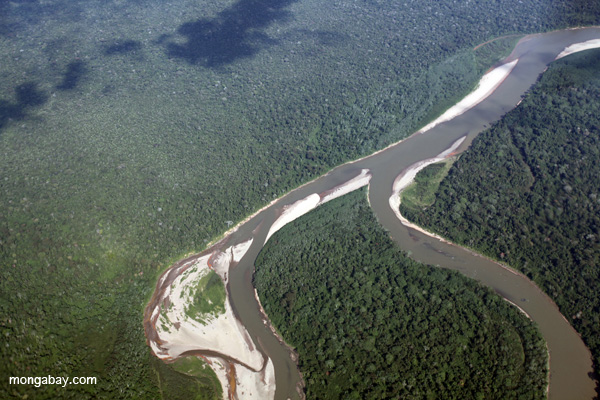
The Amazon Rainforest. Photo by Rhett Butler.
Parts of the Amazon rainforest are getting considerably less rain, leading trees to absorb less carbon, finds a study published this week in the journal Proceedings of the National Academy of Sciences.
The research is based on new satellite technology that measures rainfall more accurately than previous approaches by cutting through cloud cover. It finds that since 2000, rainfall has declined across 69 percent of the Amazon rainforest, an area amounting to 5.4 million square kilometers. The fall in precipitation is even more substantial in the region’s tropical savannas: 80 percent of those areas have experience declining rainfall.
The drop is precipitation accounts for more than half the region’s decline in “greenness” as measured by the normalized difference vegetation index (NDVI). That translates to a drop in photosynthetic activity, meaning that carbon uptake by Amazon trees is slowing.
The findings, which are consistent with a spate of other studies using different methodologies, suggest that the Amazon rainforest may be becoming less resilient to the effects of climate change. That is a worrying prospect given the importance of the Amazon as a carbon sink as well as the ecosystem’s role in generating regional rainfall: as much as 70 percent of South America’s GDP is produced in areas fed by precipitation from the Amazon.
The authors warn that should the warming trend continue, it could trigger a positive feedback loop, shifting the intertropical convergence zone (ITCZ) — a band that circles the planet and drives current rainfall patterns — toward the poles, increasing drying in the region. That in turn would exacerbate die-off, spurring increased emissions and further accelerating climate change.
“Our results provide evidence that persistent drying could degrade Amazonian forest canopies, which would have cascading effects on global carbon and climate dynamics,” write the authors.
CITATION: Thomas Hilker et al (2014). Vegetation dynamics and rainfall sensitivity of the Amazon. Proceedings of the National Academy of Sciences.
Related articles
Drought, fire reducing ability of Amazon rainforest to store carbon
(02/06/2014) New research published in Nature adds further evidence to the argument that drought and fire are reducing the Amazon’s ability to store carbon, raising concerns that Earth’s largest rainforest could tip from a carbon sink to a carbon source.
Amazon rainforest does not ‘green up’ during the dry season
(02/06/2014) Analysis of satellite imagery has cleared up a controversy over whether the Amazon rainforest ‘greens up’ during the dry season.
Amazon’s flood/drought cycle becoming more extreme, less predictable

(05/14/2013) The Amazon River’s hydrological cycle has become more extreme over the past two decades with increasing seasonal precipitation across much of the basin despite drier conditions in the southern parts of Earth’s largest rainforest, finds a new study published in Geophysical Research Letters. The research analyzed monthly Amazon River discharge at Óbidos, a point that drains 77 percent of the Amazon Basin, and compared it with regional precipitation patterns.
Rate of tree die-off in Amazon higher than conventionally believed
(02/01/2013) The rate of tree mortality in the Amazon rainforest due to storm damage and drought is 9-17 percent higher than conventionally believed, reports a study published in the Proceedings of the National Academy of Sciences (PNAS).
Amazon rainforest failing to recover after droughts
(12/24/2012) The impact of a major drought in the Amazon rainforest in 2005 persisted far longer than previously believed, raising questions about the world’s largest tropical forest to cope with the expected impacts of climate change, reports a new study published in the journal Proceedings of the National Academy of Sciences.
Advanced technology reveals massive tree die-off in remote, unexplored parts of the Amazon

(12/12/2012) Severe drought conditions in 2010 appear to have substantially increased tree mortality in the Western Amazon, a region thought largely immune from the worst effects of changes occurring in other parts of the world’s largest rainforest, reported research presented last week at the fall meeting of the American Geophysical Union (AGU). The findings suggest that the Amazon may face higher-the-expected vulnerability to climate change, potentially undercutting its ability to help mitigate greenhouse gas emissions by absorbing carbon dioxide through faster growth.
Deforestation, climate change threaten the ecological resilience of the Amazon rainforest
(01/19/2012) The combination of deforestation, forest degradation, and the effects of climate change are weakening the resilience of the Amazon rainforest ecosystem, potentially leading to loss of carbon storage and changes in rainfall patterns and river discharge, finds a comprehensive review published in the journal Nature.
2010 Amazon drought released more carbon than India’s annual emissions
(10/09/2011) The 2010 drought that affected much of the Amazon rainforest triggered the release of nearly 500 million tons of carbon (1.8 billion tons of carbon dioxide) into the atmosphere, or more than the total emissions from deforestation in the region over the period, estimates a new study published in the journal Environmental Research Letters.
Two massive droughts evidence that climate change is ‘playing Russian roulette’ with Amazon
(02/03/2011) In 2005 the Amazon rainforest underwent a massive drought that was labeled a one-in-100 year event. The subsequent die-off of trees from the drought released 5 billion tons of CO2. Just five years later another major drought struck. The 2010 drought, which desiccated entire rivers, may have been even worse according to a new study in Science, adding on-the-ground evidence to fears that climate change may inevitably transform the world’s greatest rainforest.